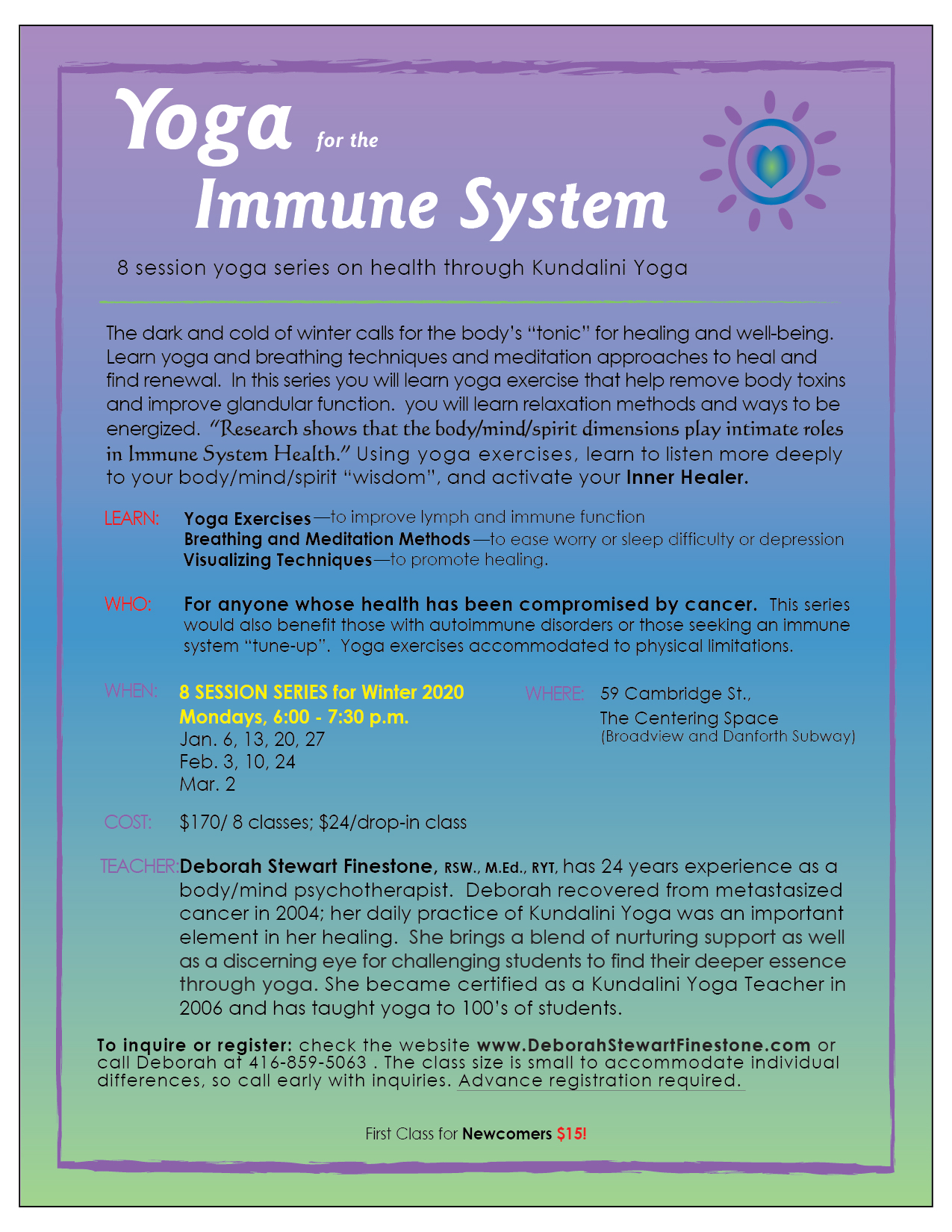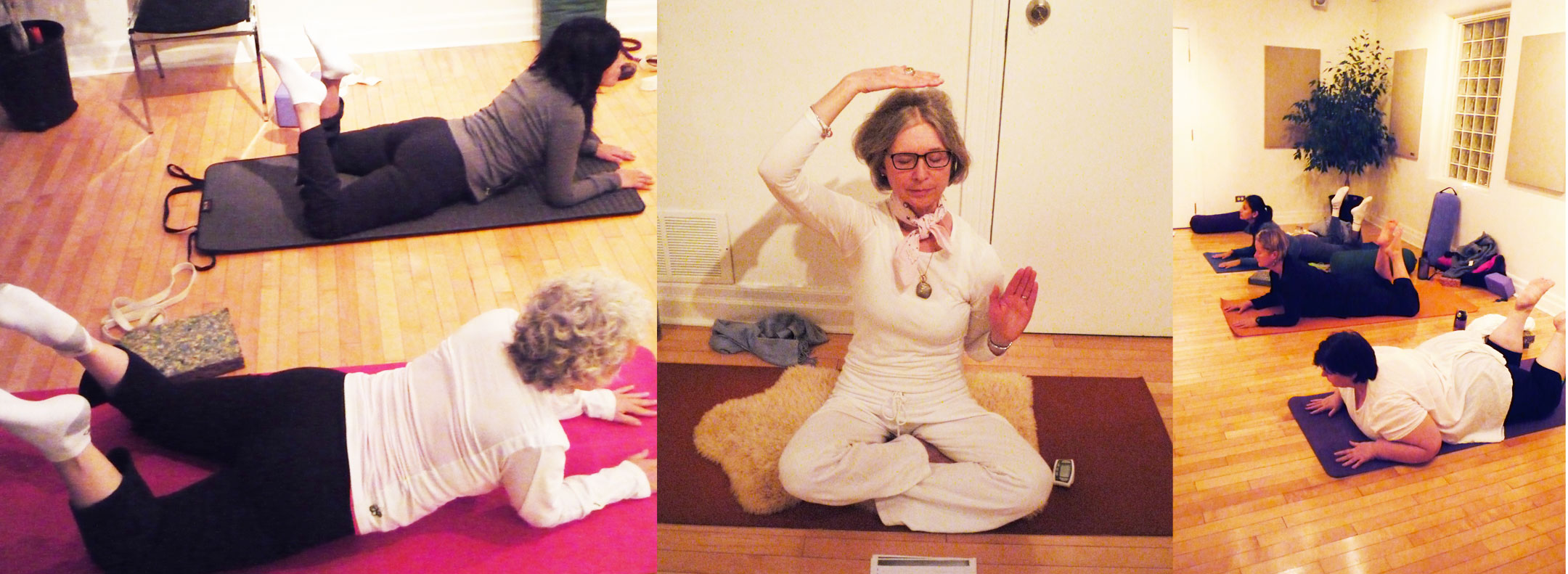When participants leave class, they feel energized, renewed and rejuvenated; often one is calm as well as relaxed, with a sense of peace and well-being. There is a written plan of the class for students to take away and use for their “back home practice”.
Kundalini Yoga
- Is your movement or motion restricted since surgery or diagnosis, or since 10 years ago?
- Do you have a chronic condition that can be minimally treatable by Western Medicine? Such as fibromyalgia, some forms of arthritis, diabetes, recurring headaches, digestion issues, chronic pain, a stiff back, trouble sleeping at night, etc. asthma or breathing issues, high or low blood pressure, etc.
- Do you have “Chemo Brain” that you would like to recuperate from, sooner rather than later?
- Are you finding it difficult to find your “joy” in life, your passion, your enthusiasm, and wondering how you might stoke the flames of these essential energies?
- Is your Immune System depleted for a range of reasons too long to list?
- Is your Immune System over active, and therefore harming your body—ie auto-immune disorders?
- Are you worried and anxious and looking for ways to “settle” so life flows more readily?
“The best vitamin you can ever take is your own Breath of Life.” -Yogi Bhajan
What is Kundalini Yoga?
Kundalini Yoga is a dynamic system combining breathing, movement, stretching and postures. Meditation, the use of sound and rhythm, and relaxation are also a part of this system. Each class includes pranayama, a sequence of postures for specific effects, relaxation and meditation. Kundalini Yoga was brought to North America, by Yogi Bhajan in 1968, but has evolved over thousands of years, originating in India. As there are a wide variety of exercises and meditations utilized in Kundalini Yoga, it can be adapted to address a wide variety of health issues.
Kundalini Yoga in the healing journey from Cancer, provides tools to:
- Settle anxiety with a cancer diagnosis, and fear generated through ongoing treatment, too.
- Support physical energy when depleted, tired, discouraged …….
- Connect through Yoga Meditation with the “Higher Self”, or the part of one that seeks and knows life meaning and purpose.
- Help one sleep, using left nostril yoga breathing, or a mantra meditation which supports sleep.
- Manage “restless leg syndrome”, using a yoga posture—called Horse Pose, that enables one to settle and return to sleep.
- Expand one’s patience, sense of calm and peace as well as compassion for one’s self and others in the cancer journey.
3 minutes of meditation affects the Electromagnetic Field, circulation and the stability of the blood.
11 minutes of meditation begins to change the nerves and the glandular system.
22 minutes of meditation balances the 3 minds [Negative Mind, Positive Mind, and Neutral Mind, and they begin to work together.
31 minutes of meditation allows the glands, breath and concventration to affect all the cells and rhythms of the body. It lets the psyche of the meditation affect the 3 gunas, all 31`tattvas and all layers of the mind’s projections.
62 minutes of meditation changes the gray matter in the brain. The subconscious “shadow mind” and the outer projection are integrated.”
—-Yogi Bhajan
*Group Classes
A typical class includes:
1) Tuning in with repeating the Mantra, “I bow to the wisdom, the indescribable wisdom within and without.”
2) A breathing exercise to connect and open the lungs and body and stimulate the brain
3) Warming Up with some basic yoga postures, such as Sun Salutation
4) Yoga Set of Postures, that is a designed to support a particular health issue—such as immune system, lymphatic system, frontal brain, and heart centre, etc.
5) Meditation—to support mental and emotional and physical health. Each meditation has a specific hand position, eye position and body posture to enhance an aspect of well-being.
6) Relaxation—(often students favourite time in the class!) A time to drop into the rest phase, the para-sympathetic aspect of being still, …finding one’s still point.
*Privates; Semi-privates
Why do a private or a semi-private class?
- I’m recovering from surgery and I still have some pain and restricted movement; can you help me with a yoga series of postures that I can do on my own, that is good for my particular body type, my particular condition/disease?
- I’m still in chemo, and it’s hard on me—is there anything I might do in Yoga to help me to manage this?
- I’m older and I have high blood pressure; is there a way for me to benefit from Yoga and manage my condition differently?
- I need a Yoga Coach who will support me learning some of the Yoga how-to’s on my own, due to my body limitations.? Can I do this in my home along with regular classes?
A Typical Private Yoga Session:
- We start with a history of your health, its strengths and limitations. We do a check on tendencies—thyroid issues, spring allergies, asthma, fibromyalgia, diabetes, etc.
- Based on your information, I select a yoga set of postures/exercises and we do that together, and we see…… What works for you, what feels right? What feels wrong?
- We follow the structure for a regular yoga class, except it’s designed specifically to your needs and/or limitations.
- During the session, we pay attention to habits or patterns that may get in the way of the yoga postures—such as a neck or head holding pattern, tightness at the low back, restrictions in arm movements, etc. I help design a simple yoga sequence to support your steps to releasing, renewing and restoring your body energy and flow.
- You learn some of the basic yoga skills, such as breathing techniques, correct yoga postures and meditation techniques through the sessions.
- We conclude the session with a relaxation and meditation; an outline of the class is provided for you to use at home.
“We have been blessed with 3 facets—body, mind and soul. Soul is the highest self; body and mind are there to serve the soul. The only situation where we fail is where we start to serve either the body or the mind. Where 2 servants start serving each other, the master goes hungry. That is why souls are hungry, souls are empty, and souls are in pain. The purpose of life, the attitude of life, is to serve the soul.” –Yogi Bhajan, July 1982
Chair Yoga for Seniors/Mat Yoga for Seniors
Chair Yoga is an ideal way to receive the benefits of yoga while managing health limitations such as reduced flexibility, joint pain, or any other reason that Mat Yoga is not a viable option. Working within the framework of yoga one is able to participate and derive greater well-being, more energy, more ways to relax and rest, more ways to experience peace and connection with self and others.
Other resources:
TorontoKundalini Yoga Teachers’ Association for more information about Kundalini yoga www.torontokundaliniyoga.com
Kundalini Yoga Training www.kundaliniyogatraining.com





